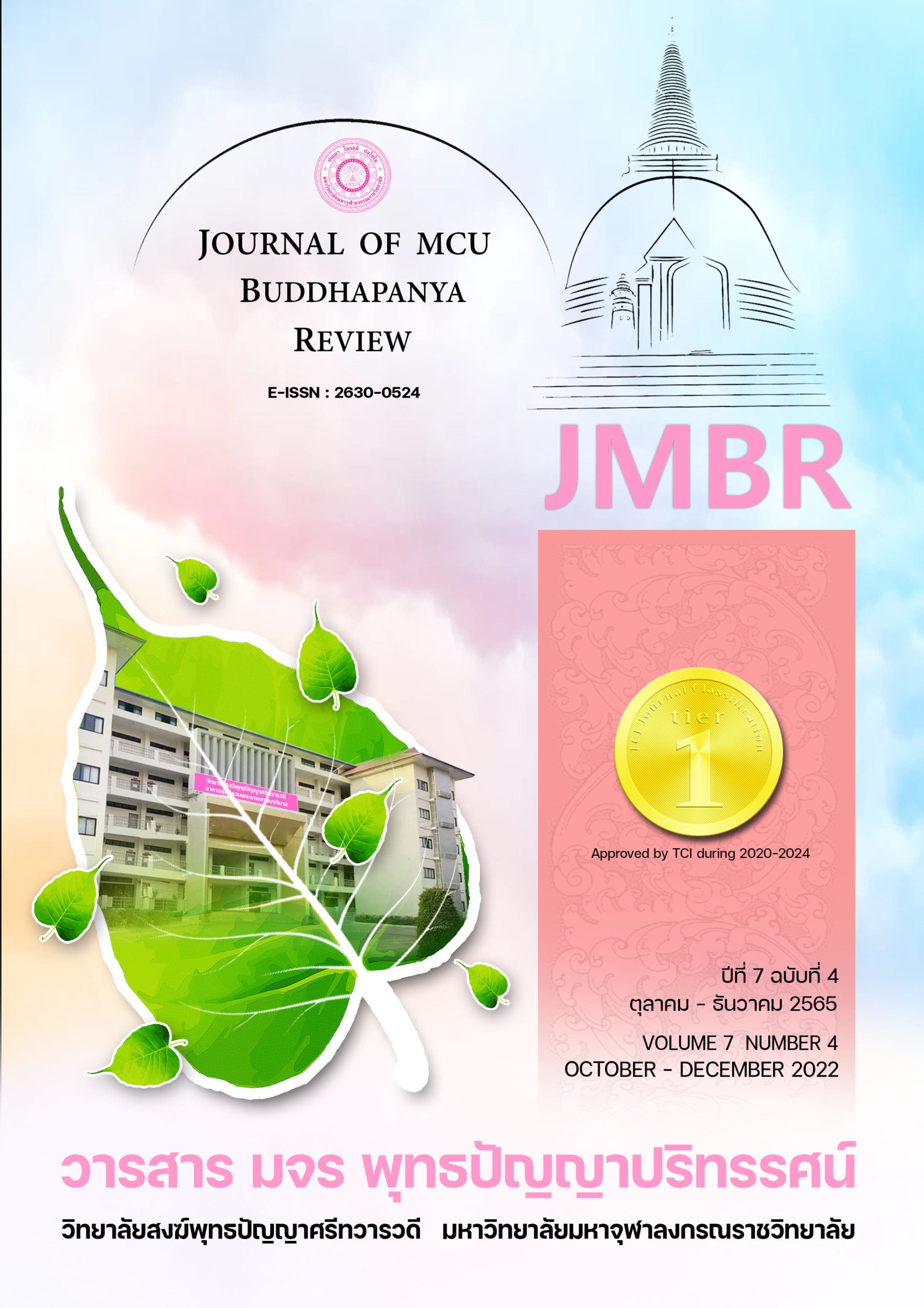ปัจจัยที่ส่งผลต่อการใช้โซเชียลคลาวด์เลิร์นนิ่ง สำหรับนักศึกษาระดับอุดมศึกษาในศตวรรษที่ 21
คำสำคัญ:
การใช้โซเชียลคลาวด์เลิร์นนิ่ง , นักศึกษาระดับอุดมศึกษา , ศตวรรษที่ 21บทคัดย่อ
งานวิจัยนี้มีวัตถุประสงค์เพื่อ 1) เพื่อศึกษาค่าเฉลี่ยของปัจจัยที่ส่งผลต่อการใช้โซเชียลคลาวด์เลิร์นนิ่งและการใช้โซเชียลคลาวด์เลิร์นนิ่ง 2) เพื่อศึกษาความสัมพันธ์ระหว่างปัจจัยที่ส่งผลต่อการใช้โซเชียลคลาวด์เลิร์นนิ่ง กับการใช้โซเชียลคลาวด์เลิร์นนิ่ง และ 3) เพื่อสร้างสมการการทำนายของการใช้โซเชียลคลาวด์เลิร์นนิ่งสำหรับนักศึกษาระดับอุดมศึกษา กลุ่มตัวอย่างคือนักศึกษาระดับปริญญาตรีในสถาบันอุดมศึกษาที่เคยใช้โซเชียลคลาวด์เลิร์นนิ่งจำนวน 400 คน ได้มาจากการสุ่มตัวอย่าง แบบหลายขั้นตอน เครื่องมือที่ใช้ในการเก็บรวบรวมข้อมูลคือแบบสอบถาม เครื่องมือที่ใช้ในการวิจัยคือ แบบสอบถาม วิเคราะห์ข้อมูลใช้สถิติบรรยาย ค่าสัมประสิทธิ์สหสัมพันธ์เพียร์สันโพรดักโมเมนต์ และการวิเคราะห์ถดถอยพหุคุณแบบเป็นขั้นตอน ผลการวิจัยที่สำคัญสรุปได้ดังนี้ 1) การรับรู้ว่าง่ายต่อการใช้งานเป็นปัจจัยที่มีค่าเฉลี่ยสูงสุด รองลงมา คือ คุณภาพของระบบ ทักษะพื้นฐานด้านไอซีที คุณภาพ ของข้อมูล การรับรู้ถึงประโยชน์ การใช้โซเชียลคลาวด์เลิร์นนิ่ง และคุณภาพของบริการ 2) พบว่า ปัจจัยทั้ง 5 ปัจจัย คือ ทักษะพื้นฐานด้านไอซีที (BAS) คุณภาพของข้อมูล (INF) คุณภาพของระบบ (SYS) การรับรู้ถึงประโยชน์ (PU) และการรับรู้ว่าง่ายต่อการใช้งาน (PEOU) มีความสัมพันธ์กับตัวแปรการใช้โซเชียลคลาวด์เลิร์นนิ่งอย่างมีนัยสำคัญทางสถิติที่ระดับ .05 ยกเว้นปัจจัยคุณภาพของบริการ และ 3) ปัจจัยทั้ง 6 ปัจจัยสามารถร่วมกันทำนายความแปรปรวนในตัวแปรการใช้โซเชียลคลาวด์เลิร์นนิ่งได้ร้อยละ 63.40 มีปัจจัยคุณภาพของระบบเป็นตัวแปรพยากรณ์ที่ดีที่สุดโดยมีค่าสัมประสิทธิ์การถดถอยมาตรฐานเท่ากับ .384 และปัจจัยคุณภาพของบริการเป็นตัวแปรพยากรณ์ที่มีค่าต่ำสุดเท่ากับ .078
เอกสารอ้างอิง
Chiu, P. S., Chao, I. C., Kao, C. C., Pu, Y. H., & Huang, Y. M. (2016). Implementation and evaluation of mobile e-books in a cloud bookcase using the information system success model. Library Hi Tech. Vol. 34 No. 2, 2016 pp. 207-223
Hussein, L. A., & Hilmi, M. F. (2020). Cloud Computing Based E-learning in Malaysian Universities. International Journal of Emerging Technologies in Learning, 15(8).
Al-Hajri, S., Echchabi, A., Ayedh, A. M., & Omar, M. M. S. (2021). The Cloud Computing Systems' Adoption in the Higher Education Sector in Oman in Light of the COVID-19 Pandemic. International Journal of Evaluation and Research in Education, 10(3), 930-937.
Noh, N. H. M., & Amron, M. T. (2021). Exploring Cloud Computing Readiness and Acceptance in Higher Education Institution: A PLS-SEM Approach. Asian Journal of University Education, 17(4), 367-376.
Lew, S. L., & Lau, S. H. (2020). An empirical study of students' intention to use cloud e-learning in higher education. International Journal of Emerging Technologies in Learning (iJET), 15(9), 19-38.
Naveed, Q. N., Alam, M. M., Qahmash, A. I., & Quadri, K. M. (2021). Exploring the determinants of service quality of cloud e-learning system for active system usage. Applied Sciences, 11(9), 4176.
Amornkitpinyo, T., Yoosomboon, S., Sopapradit, S., & Amornkitpinyo, P. (2021). The Structural Equation Model of actual use of Cloud Learning for Higher Education students in the 21st century. Journal of e-Learning and Knowledge Society, 17(1), 72-80.
Lew, S. L., & Lau, S. H. (2020). An empirical study of students' intention to use cloud e-learning in higher education. International Journal of Emerging Technologies in Learning (iJET), 15(9), 19-38.
Boholano, H. B. (2017). “Smart social networking: 21st century teaching and learning skills.” Research in Pedagogy. Vol.7 No.1 : 21-29.
DeLone, W. H., and McLean, E. R. (2003). “The DeLone and McLean model of information systems success: A ten-year update.” Journal of Management Information Systems. Vol.19 No.4 : 9-30.
SOPAPRADIT, S. (2022). STEM LEARNING SYSTEM WITH THE INTERNET OF THINGS THROUGH CLOUD LEARNING TO DEVELOP THE DIGITAL LITERACY AND CREATIVE PRODUCTS OF HIGHER EDUCATION STUDENTS IN THE 21ST CENTURY. Journal of Theoretical and Applied Information Technology, 100(20).
Sultana, J. (2020). Determining the factors that affect the uses of Mobile Cloud Learning (MCL) platform Blackboard-a modification of the UTAUT model. Education and Information Technologies, 25(1), 223-238.
Intel Corporation. (2021). “Schools, IT, and Cloud Computing The Agility for 21st Century eLearning”,Available: https://www.intel.co.uk /content/dam/doc /case-study/cloud-computingeducation-21st-century-e-learning-study.pdf
Iyer B. and Henderson J. C., (2010). “Preparing for the future: Understanding the seven capabilities cloud computing”, MIS Quarterly Executive, Vol. 9 No. 2, pp.117-131.
Mareeyae, A., Ninna, J. & Noppakao, N. (2019). “STEM Education on biochemistry of grade 12 Students”, The 2019 Pure and Applied Chemistry International Conference (PACCON 2019), pp. 1–6, 2019, [Online]. Available: https://mis.sci.tsu.ac.th/sciservice/WebSci/pdf_ aca/2020-06-26_135505.pdf
Eric Knorr. (2018) “What is cloud computing? Everything you need to know now”. Available: https://www.infoworld.com/article/2683784/what-is-cloud-computing.html
Davis, F. D. (1989). Perceived usefulness, perceived ease of use, and user acceptance of information technology. MIS quarterly, 319-340.
ดาวน์โหลด
เผยแพร่แล้ว
รูปแบบการอ้างอิง
ฉบับ
ประเภทบทความ
สัญญาอนุญาต
ลิขสิทธิ์ (c) 2022 วารสาร มจร พุทธปัญญาปริทรรศน์

อนุญาตภายใต้เงื่อนไข Creative Commons Attribution-NonCommercial-NoDerivatives 4.0 International License.



